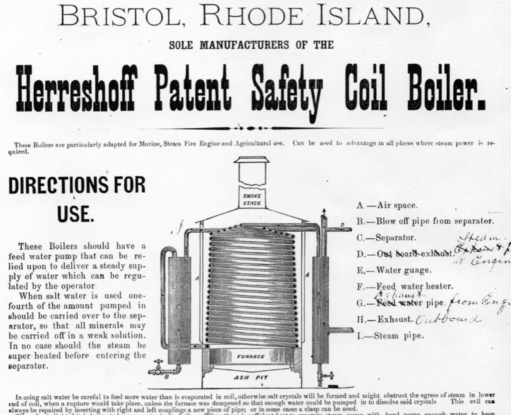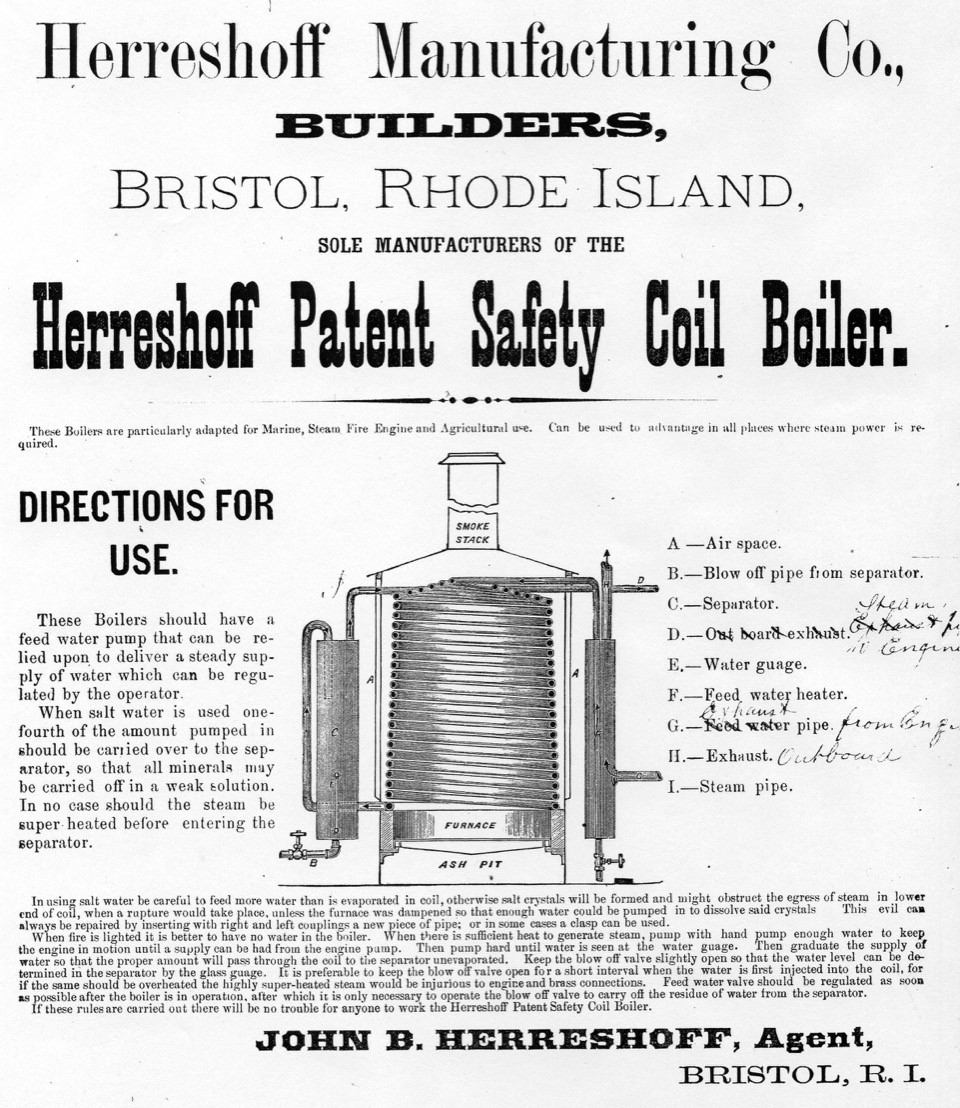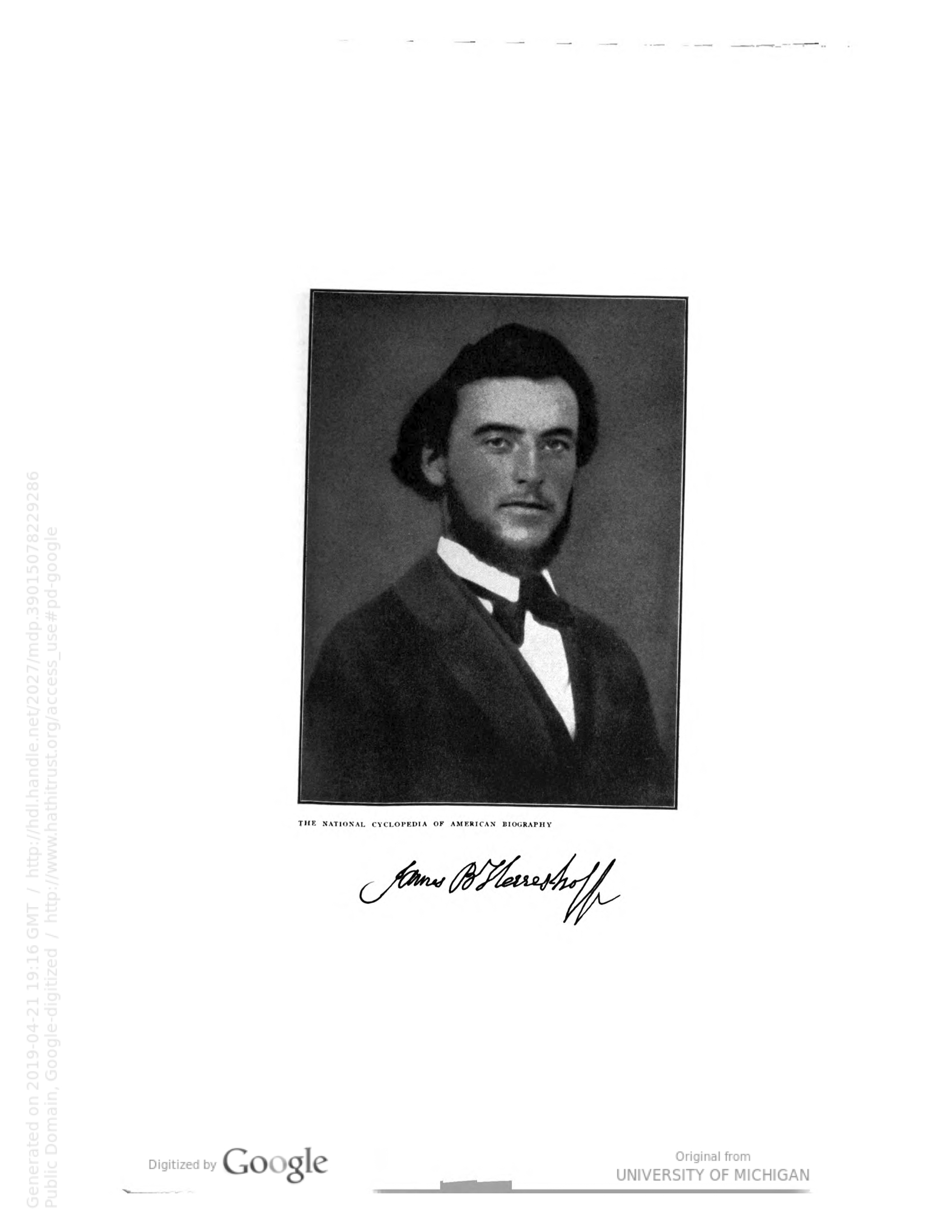August 15, 2019
Curator’s Log, August 2019: “Herreshoff Biographies: Part Two”
This is the second of a multi-part series on Captain Nat Herreshoff’s (1848-1938) efforts, starting in 1926 and extending into the early 1930s, to correct and add to the published biographies of himself and his two older brothers, James Brown Herreshoff (1834-1930) and John Brown Herreshoff (1841-1915).

Curator’s Log August 2019
Captain Nat and the Herreshoff Biographies-
Part Two; Correcting the Record: James B. Herreshoff and the Herreshoff Manufacturing Co.
Introduction
This is the second of a multi-part series on Captain Nat Herreshoff’s (1848-1938) efforts, starting in 1926 and extending into the early 1930s, to correct and add to the published biographies of himself and his two older brothers, James Brown Herreshoff (1834-1930) and John Brown Herreshoff (1841-1915).
(To see first Log in this series; “April 2019; Captain Nat and the Herreshoff Biographies-Part One; The Bios of 1904”, click here.)
This month we examine Capt. Nat’s views on James Brown Herreshoff, and the part he played in the establishment and success of the Herreshoff Manufacturing Co. (HMCo).
James Brown Herreshoff (1834-1930) (Figure 1)
James, Capt. Nat’s eldest brother, was a successful business man, manufacturing chemist and prolific inventor across a wide field of endeavor. Completing his education in chemistry at Brown in 1855, he instructed for a short time before entering industry where he achieved business, financial and technical success. Among his many improvements, inventions and patents- a new baking powder, improved processing of fish oils, refining of copper, manufacturing of nitric acid, dyes/paints and the vulcanizing of rubber. In the marine field he patented the safety coil steam boiler, the mainstay of John Brown Herreshoff’s boatbuilding business in the 1870s and developed a mercury-based antifouling paint. He left industry short of his 40th birthday, continuing as a consultant and inventor and spending considerable time in England and France. James died in Bristol at the age of 96.
James New York Times 1930 obituary credits him with inventing the “coil boiler, and the fin keel for yachts”, representing John and Nat abroad “as foreign representative for the Herreshoff boat-building plant”, and being “responsible for many improvements in design embodied in the (America’s Cup) defenders” by the Herreshoff Manufacturing Co.1
Captain Nat Reacts to the James 1904 Biography: April 27, 1926
Upon reading the copy of James’ 1904 biography sent to him by The Cyclopedia’s F. W. Wilson he was drawn to respond to the following claims-“In 1873 he produced his coil-boiler, a pattern now very popular; and this was soon followed by the invention of the fin-keel for sailing yachts and mercurial antifouling paint. These three inventions have enabled the Herreshoff Manufacturing Co. to construct the fastest steam and sailing yachts in the world.”2
F. W. Wilson, Assistant Editor Apr. 27, 1926
Dear Sir Referring, to yours of 6th and inclosures
My brother James B. who is now 92 and in somewhat enfeebled condition mentally had quite an unusual inventive ability. The old saw, “There is nothing new under the sun.” The particular arrangement of flash boiler known as coil boiler as far as I know originated with him. The well known Herreshoff Manufacturing Co. was founded by my brother John B. in 1864. James B. had no connection with it at any time and no interest other than the friendship of a brother. He made the first coil boiler in John’s shop in 1874.
John was much interested and helped him carry it out. They cooperated in building a boat to try it out and John supplied the engine and other details. In very small sizes the boiler did well enough to gain quite a reputation, but when my brother John undertook to make a business of building them it came near causing his undoing, for as larger ones were made and sold they proved quite unreliable so that lawsuits began turn up. When I joined my brother John in 1878 I worked hard to overcome the difficulties met with, but we soon decided the coil boiler to be impractical and It was entirely given up in spring of 1880, and in its place we began to manufacture a water tube boiler of my design in which there was a steam drum with water level. The coil boiler had only a precarious life of 6 years and was absolutely dead before the H.M.Co. gained any world wide reputation.
The fin or more properly ballast fin keel was 1st described in old English records of over 100 years ago. The leaded centreboard that my brother James experimented with was quite a different affair from the so called fin keel boat that the H.M.Co. built so many of between 1892 and 1900. These were from my designs and in no way copy of James’ experiments. My brother James experiments were not taken up at all by the H.M.Co. I have only gone into these details that credit for the success of the H.M.Co. should be properly recorded. 3
Commentary on Capt. Nat’s Response (Figure 2)
Let us analyze Nat’s three key points
- James had no formal or substantive connection with the boat building business that John started and continued in partnership with Nat.
- James’ “interest” in the business was more than just “friendship of a brother”. He was continually offering unsolicited design ideas from his fertile brain. For example, the “sheets with sketches of boats and engines” he mailed to Nat during Nat’s time at Corliss.4 VISION (HMCo 14) built while Nat was in Europe and the first production launch equipped with the coil boiler had a new high pressure version of an HMCo single cylinder engine; a modification most likely developed by James.
- James represented HMCo in England and Europe, and it was through James that Englishman George R. Dunell became acquainted with Herreshoff, selling HMCo launches and torpedo boats to both the Admiralty and the Russian navy.
- James invention, the coil boiler, was a limited success lasting only 6 years (1874-1880), eventually proved unreliable despite Nat’s best efforts, and predated HMCo gaining a worldwide reputation. And it certainly was no longer “very popular” in 1904 when the bio was published
- Nat under states the importance of the coil boiler. It was the success of high-speed launches powered by the coil boiler that brought HMCo its first international recognition. In 1873 John with few orders had let go some of his most experienced craftsmen. That all changed with the coil boiler; annual delivery of steam powered vessels increased from 2 to in excess of 10 per year continuing into 1884 (not 1880); the year after Nat introduced the water level square boiler. In fact, as Nat acknowledged in 1934, it was the good prospects of building the steam powered business (then 100% coil boilers) that enticed Nat to join John at HMCo in late 1877.5
- There were technical problems with the coil boiler. The long coil was difficult to manufacture, could not be mechanically cleaned in service, had a limited life and required continual attention to maintain correct steam flow to avoid burning out tubes and excessive superheat from inadequate flow or conversely water carry over into the engine from excessive flow. The Admiralty noted it took an especially attentive boiler tender to operate; the problem they did not have such a rating in their navy- they only had boiler tenders. These problems were exacerbated with increase in size as the coils grew from the original 22-inch diameter to as much as 7-feet.
- James did not invent or influence the design of the ballast fin keel as applied by HMCo in its 1890s fin keelers, or, later America’s Cup keel boats.
- Here we have available to us at this museum and MIT’s Hart Nautical Collection full documentation (preliminary design sketches, Naval Architecture and Engineering Notes, half-models, off-set books, and HMCo production drawings) of the fin keel designs to back up what Nat wrote in 1926.
- There is one caveat, Nat’s approach to keel designs may have been influenced at some time by a long lost note or sketch from James – we probably will never know.
James Brown Herreshoff Bio- Postscript
Nat’s 1926 remarks were ignored by the editors of the Cyclopedia. There was no change to James bio until 1958 when an extensive revision expanded upon James Importance to the success of the HMCo. You can read it here.6 It was probably influenced by a pamphlet published by James eldest daughter Jeanette in 1949 to “reveal “ her father’s rightful place in the “galaxy of early day geniuses and inventors of the early period of our nation”, (where) James B. Herreshoff stands out like a planet in perihelion”, by rendering a more accurate account of the HMCo than that set out by others who “have been rather meager in some aspects, and, no doubt unintentionally, somewhat one-sided in some directions”. Her writing, a collection of some truths and many unfounded assertions, deserves a separate analysis.7
John Palmieri

HMCo Safety Coil Boiler (Herreshoff Marine Museum Archives) 
"James B. Herreshoff as a young man. (Cyclopedia American Biography Vol 42, 1958”)
1. “J. B. Herreshoff, Inventor Dies at 96”, New York Times, Dec. 7, 1930
2. “James Brown Herreshoff Biography”, The National Cyclopedia of American Biography, Vol 12, 1904. Pg. 353. Link
3. Nat Herreshoff handwritten draft. L. Francis Herreshoff Collection 138, Mystic Seaport. Box 16 Folder 13; 2 of 24.
4. Jeannette Brown Herreshoff, The Early Founding and Development of the Herreshoff Manufacturing Company. Rinaldi Printing Co. Tampa FL, 1949. Pages are not numbered. (Available Herreshoff Marine Museum archives) Quote is from an 1872 letter from Nat to James thanking him for the material.
5. Nathanael G. Herreshoff, “Some of the Boats I have Sailed In”. Recollections. Herreshoff Marine Museum, Bristol RI 1998. Pg 52.
6. “James Brown Herreshoff Biography”, The National Cyclopedia of American Biography, Vol 42, 1958. Pgs. 88-89. Link
7. Jeannette Brown Herreshoff, The Early Founding and Development of the Herreshoff Manufacturing Company.
